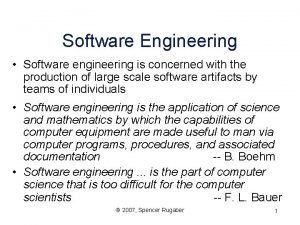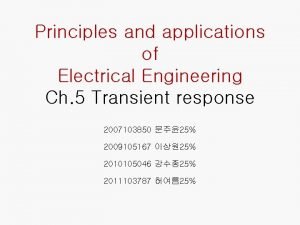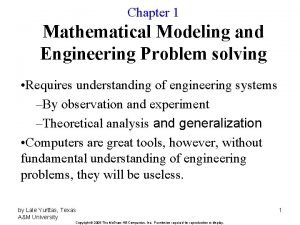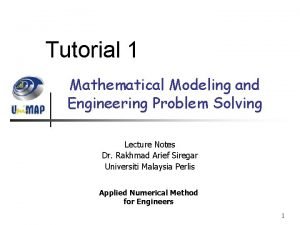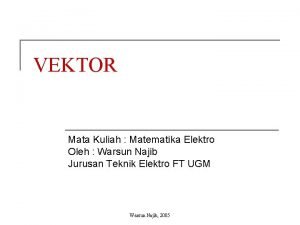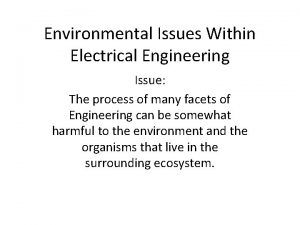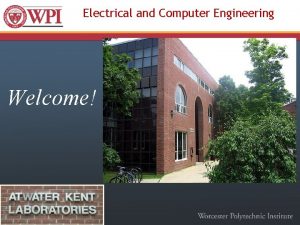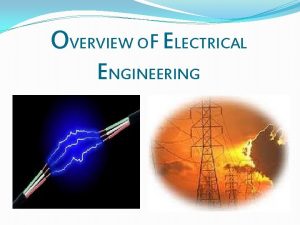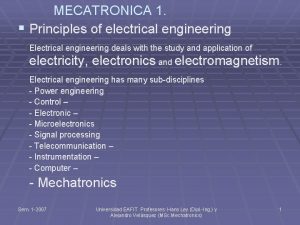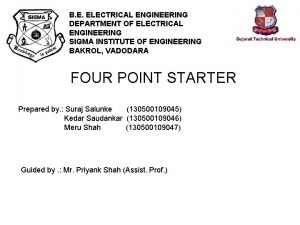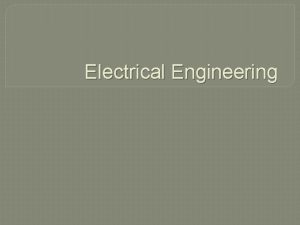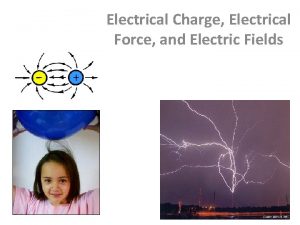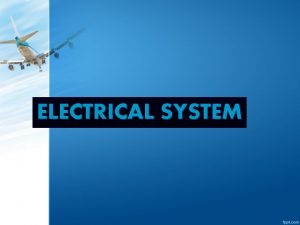INTRODUCTION Electrical and Computer Engineering Concerned with solving




























- Slides: 28

INTRODUCTION

Electrical and Computer Engineering Concerned with solving problems of two types: 1. Production or transmission of power.

Electrical and Computer Engineering Concerned with solving problems of two types: 2. Transmission or processing of information Communication Systems Designers deal with the transmission of information.

Electrical and Computer Engineering Electric Energy Systems and Communication Systems have Markedly different sets of constraints. Electric Energy Systems deal with known waveforms and one is concerned with designing the system for minimum energy loss.

Electrical and Computer Engineering Electric Energy Systems and Communication Systems have Markedly different sets of constraints. Communication Systems deal with unknown waveforms and try to overcome the problems of noise interference.

Main concerns of the Communication System Designers Selection of the information-bearing waveform Bandwidth and power of the waveform Effect of System Noise on the received information Cost of the System

Digital and Analog Sources and Systems A digital information source produces a finite set of possible messages An analog information source produces messages that are defined on a continuum.

Digital and Analog Sources and Systems A digital communication system transfers information from a digital source to the intended receiver (also called the sink). An analog communication system transfers information from an analog source to the sink.

Digital and Analog Sources and Systems In the process of communication the transmitter usually alters (modulates) a property of a known waveform according to the message. For example the amplitude of a sine wave is modulated according to the audio content in a AM radio station.

Digital and Analog Sources and Systems Strictly speaking, a digital waveform is defined as a function of time that can have only a discrete set of amplitude values. If the digital waveform is a binary waveform, only two values are allowed. + An analog waveform is a function of time that has a continuous range of values.

Advantages and disadvantages of Digital Communication Advantages: Relatively inexpensive circuits may be used. Privacy is preserved by using data encryption. Greater dynamic range is possible. Data from voice, video, and data sources may be merged and transmitted over a common digital system. In long distance systems, noise does not accumulate from repeater to repeater. Errors in detected data may be small, even when there is a large amount of noise on the received channel. Errors may often be corrected with the use of coding.

Advantages and disadvantages of Digital Communication Disadvantages: Generally, more bandwidth is required that for analog Systems. Synchronization is required

Deterministic and Random Waveforms A deterministic waveform can be modeled as a completely specified function of time Example:

Deterministic and Random Waveforms A random waveform ( or stochastic waveform) cannot be completely specified as a function of time and must be modeled probabilistically.

Deterministic and Random Waveforms Communication systems deal with random waveforms because we do not know exactly which messages will be transmitted. This requires the use of probabilistic and statistical concepts. However if we represent the signal by a "typical" deterministic waveform, we can obtain most of the results we are seeking.

Block Diagram of a Communication System A communication systems involve three main subsystems: Transmitter Channel Receiver Depending of the application the message could be of analog or digital nature

Block Diagram of a Communication System

Block Diagram of a Communication System The signal processing block of the transmitter conditions the source for more efficient transmission (analog filtering, ADC + parity bits, etc. ) The transmitter carrier circuit converts the processed baseband signal into a frequency band that is appropriate for the transmission medium. If the channel propagates baseband signals, no carrier circuits are needed.

Block Diagram of a Communication System

Frequency allocations Wireless communication systems often use the atmosphere for the transmission channel Interference and propagation conditions are strongly dependent on the transmission frequency To minimize interference government regulations specify the modulation type, bandwidth, power and type of information that a user can transmit for the different bands. Frequency assignments and technical standards are set internationally by the International Telecommunications Union (ITU).

Frequency allocations In the united States, the FCC regulates and licenses radio systems for the general public and state and local government. The National Telecommunication and Information Administration (NTIA) is responsible for U. S. government and U. S. military frequency assignments.

Frequency allocations

Frequency allocations

Propagation of Electromagnetic Waves The propagation characteristics of electromagnetic waves used in wireless channels are highly dependent of the frequency, air temperature, air density, and Levels of ionization establish the boundary conditions for the three propagation modes that take place in the atmosphere.

Propagation of Electromagnetic Waves

Propagation of Electromagnetic Waves

Propagation of Electromagnetic Waves

 Klipsch school of electrical and computer engineering
Klipsch school of electrical and computer engineering Tum department of electrical and computer engineering
Tum department of electrical and computer engineering Spencer rugaber
Spencer rugaber System procurement process in software engineering
System procurement process in software engineering Electrical estimate and costing
Electrical estimate and costing Ts-2di
Ts-2di Principles and applications of electrical engineering
Principles and applications of electrical engineering Allan
Allan Mathematical modeling and engineering problem solving
Mathematical modeling and engineering problem solving Mathematical modeling and engineering problem solving
Mathematical modeling and engineering problem solving Elektro vektor
Elektro vektor Gwu electrical engineering
Gwu electrical engineering Tel aviv university electrical engineering
Tel aviv university electrical engineering Northwestern university computer engineering
Northwestern university computer engineering Electrical engineering department
Electrical engineering department Umd ece faculty
Umd ece faculty Electrical engineering environmental issues
Electrical engineering environmental issues Wpi computer science tracking sheet
Wpi computer science tracking sheet Electrical engineering presentation
Electrical engineering presentation Kfupm ee faculty
Kfupm ee faculty Big data in electrical engineering
Big data in electrical engineering Chapter 11 electrical engineering
Chapter 11 electrical engineering Basic electrical engineering kulshreshtha
Basic electrical engineering kulshreshtha University of belgrade school of electrical engineering
University of belgrade school of electrical engineering Electrical engineering notation
Electrical engineering notation Ntou ee
Ntou ee Hello im human
Hello im human Clemson university electrical engineering
Clemson university electrical engineering Usf learn
Usf learn


